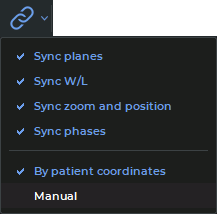5.6. Series Synchronization in MPR Reconstruction Tabs
Series synchronization is used for viewing series of one or several studies simultaneously. The opportunity to compare series created at different times allows the user to evaluate the changes and improves diagnostic accuracy. Series can be compared in MPR reconstruction tabs.
To compare series, open them in MPR reconstruction tabs. The tabs may:
-
be placed in the main program window or be unattached to it;
-
be placed on the same or on different monitor screens. The monitors may be different in size and have different settings (e.g. scaling, resolution, brightness, contrast etc.).
To enable synchronization, click the Sync series  button. Synchronization provides the user
an opportunity to change window width and level (W/L) settings, move, scale and scroll images from
different series in section plane windows. Synchronization is disabled by default. If synchronization is
enabled and the user opens a new tab, the new tab will be synchronized with the one that was opened
earlier.
button. Synchronization provides the user
an opportunity to change window width and level (W/L) settings, move, scale and scroll images from
different series in section plane windows. Synchronization is disabled by default. If synchronization is
enabled and the user opens a new tab, the new tab will be synchronized with the one that was opened
earlier.
To set synchronization types and modes, proceed as follows:
-
Click the arrow on the right-hand side of the Sync series
 button on the toolbar.
button on the toolbar.
-
Select the synchronization types and modes from the drop-down menu (Fig. 5.7):
-
Sync planes. Planes and rotation angles of orthogonal planes are synchronized in MPR reconstruction tab windows (Axial plane, Coronal plane and Sagittal plane). Other MPR reconstruction tab windows are not synchronized;
-
in the By patient coordinates mode, synchronization is only performed for series with the same frameOfReferenceUid tag value. If synchronization is enabled, the orthogonal planes of the new tab are synchronized with the planes of the tab that was opened earlier;
-
in the Manual mode, synchronization is performed for series with different frameOfReferenceUid tag values. In this case, the same changes regarding scrolling the synchronized and the synchronizing viewer window will be applied in the patient’s coordinate system. Planes in synchronized windows will be turned around the line of intersection of orthogonal planes through the same angle;
-
-
Sync W/L. Changes in the window width and level (W/L) will be synchronized for series with the CT modality. For series with other modalities, synchronization will only be performed if the modalities of the series and the recommended width and level (W/L) values are the same. Series with different modalities cannot be synchronized. The chosen mode has no impact on this synchronization type.
If synchronization has been enabled, the window width and level (W/L) values of the tab opened will be synchronized with those of the tab that was opened earlier.
Merged series are synchronized layer by layer. Layers are synchronized by their respective numbers (the first layer is synchronized with the first one, the second layer is synchronized with the second one etc.);
-
Sync zoom and position. The scaling and position changes are synchronized in MPR reconstruction tab windows (Axial plane, Coronal plane, and Sagittal plane). Other MPR reconstruction tab windows are not synchronized. Merged series are synchronized on the basis of the data for the first layers of the series. This synchronization type functions differently depending on the mode chosen.
-
in the By patient coordinates mode:
-
synchronization is only performed for series with the same frameOfReferenceUid tag value;
-
the actual image size is taken into account. For sections of the same size, objects are displayed in the same way;
-
window centers are synchronized. In the window center, the user sees the projection of the center point of the synchronizing window on the synchronized window section;
-
if synchronization is enabled, the scale and the position of the image in the new tab will be synchronized with the scale and the position of the image in the tab that was opened earlier;
-
-
in the Manual mode:
-
the actual image size is taken into account. For sections of the same size, objects are displayed in the same way;
-
if the position of the synchronizing window center is changed, the position of the synchronized window center is changed accordingly;
-
if synchronization is enabled, the scale of the new tab will be synchronized with the scale of the tab that was opened earlier. The position will be synchronized in compliance with the changes in the synchronizing section position;
-
-
-
Sync phases. The image phases are synchronized by number. If the phase number for the synchronizing series is greater than the total number of phases in the synchronized series, then the phase with the greatest number will be selected for the synchronized series. This synchronization type does not depend on the chosen mode.
-

